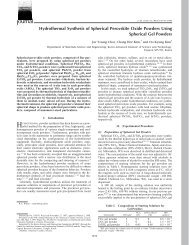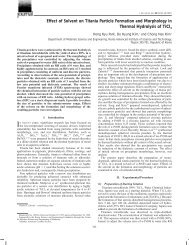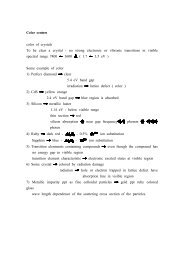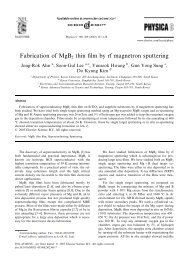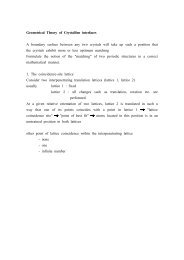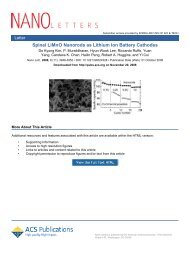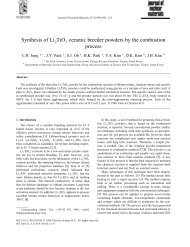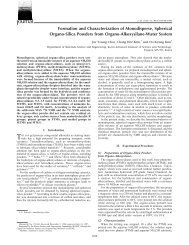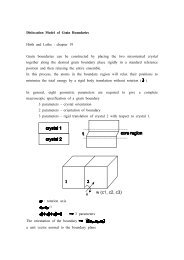Hydrogen storage characteristics of metal oxide doped Al–MCM-41 ...
Hydrogen storage characteristics of metal oxide doped Al–MCM-41 ...
Hydrogen storage characteristics of metal oxide doped Al–MCM-41 ...
You also want an ePaper? Increase the reach of your titles
YUMPU automatically turns print PDFs into web optimized ePapers that Google loves.
<strong>Hydrogen</strong> <strong>storage</strong> <strong>characteristics</strong> <strong>of</strong> <strong>metal</strong> <strong>oxide</strong> <strong>doped</strong><br />
<strong>Al–MCM</strong>-<strong>41</strong> mesoporous materials<br />
Savidha Ramachandran, Jang-Hoon Ha, Do Kyung Kim *<br />
Department <strong>of</strong> Material Science and Engineering, Korea Advanced Institute <strong>of</strong> Science and Technology (KAIST), Taejeon 305-701, Republic <strong>of</strong> Korea<br />
Abstract<br />
Received 24 October 2005; received in revised form 15 March 2007; accepted 19 March 2007<br />
Available online 4 April 2007<br />
The feasibility and perspectives <strong>of</strong> <strong>Al–MCM</strong>-<strong>41</strong> as hydrogen <strong>storage</strong> systems were evaluated. The <strong>Al–MCM</strong>-<strong>41</strong> with varying content<br />
<strong>of</strong> aluminum was synthesized by hydrothermal process. Different <strong>metal</strong> <strong>oxide</strong>s were impregnated over <strong>Al–MCM</strong>-<strong>41</strong> by incipient wetness<br />
impregnation (IWI) method. The crystallnity <strong>of</strong> the samples were interrogated by powder X-ray diffraction. The textural properties were<br />
measured by N 2 sorption method. The structural properties were established by Transmission Electron Microscope (TEM). The gas<br />
chromatogram indicates that hydrogen uptake in <strong>Al–MCM</strong>-<strong>41</strong> is strongly dependent on density <strong>of</strong> Brønsted acid sites and the amount<br />
<strong>of</strong> <strong>metal</strong> <strong>oxide</strong> (especially NiO).<br />
Ó 2007 Elsevier B.V. All rights reserved.<br />
Keywords: <strong>Hydrogen</strong>; Storage; MCM-<strong>41</strong>; Nickel; Impregnation<br />
1. Introduction<br />
Available online at www.sciencedirect.com<br />
Catalysis Communications 8 (2007) 1934–1938<br />
<strong>Hydrogen</strong>, for long has been proved to be the most ideal<br />
fuel for <strong>storage</strong>, transport and conversion <strong>of</strong> energy for a<br />
comprehensive clean energy concept [1]. <strong>Hydrogen</strong> as an<br />
energy carrier is limited by problems related to its <strong>storage</strong>.<br />
Concerning the point <strong>of</strong> hydrogen <strong>storage</strong>, as at room temperature<br />
and at atmospheric pressure hydrogen occupies<br />
about 3000 times the volume <strong>of</strong> gasoline providing the<br />
same amount <strong>of</strong> energy, it must be mechanically compressed,<br />
liquefied or subjected to some other sophisticated<br />
<strong>storage</strong> methods to be used for practical purpose [2–4].<br />
Storage <strong>of</strong> hydrogen is either too expensive or too heavy,<br />
takes too much volume and/or is unsafe. Adsorptive <strong>storage</strong><br />
<strong>of</strong> gaseous hydrogen is an inherently safe and attractive<br />
technology. Advanced materials under development to<br />
achieve this goal include <strong>metal</strong> hydrides, alloys, inter<strong>metal</strong>lics,<br />
sodium and lithium alanates, nanotubes and carbon<br />
based materials [5]. Several <strong>metal</strong> hydrides are available<br />
commercially, representing a good solution for hydrogen<br />
* Corresponding author. Tel.: +82 42 869 <strong>41</strong>18; fax: +82 42 869 3310.<br />
E-mail address: dkkim@kaist.ac.kr (D.K. Kim).<br />
1566-7367/$ - see front matter Ó 2007 Elsevier B.V. All rights reserved.<br />
doi:10.1016/j.catcom.2007.03.029<br />
www.elsevier.com/locate/catcom<br />
<strong>storage</strong>. Among the various forms <strong>of</strong> carbon such as graphite,<br />
diamond, fullerenes and single walled carbon nanotubes,<br />
the carbon nanotubes were claimed to possess<br />
abnormal performance as a hydrogen carrier. However,<br />
there is a big controversy on this claim both experimentally<br />
and theoretically. The high <strong>storage</strong> capacity claimed<br />
already had not been reproducible by other researchers<br />
working in the same field [6].<br />
The necessity for engineering a new type <strong>of</strong> hydrogen<br />
adsorbent arises since no approach satisfies all the factors<br />
viz, efficiency, size, weight, cost and safety requirements<br />
for personal transportation vehicles. More recently the<br />
interest in inorganic compositions and materials has shifted<br />
to the design <strong>of</strong> materials used in catalyst technology [7].<br />
Porous crystalline solids build up from TO4 tetrahedra,<br />
are potentially attractive materials for the safe <strong>storage</strong> <strong>of</strong><br />
significant amounts <strong>of</strong> hydrogen [8]. The application <strong>of</strong><br />
zeolites as a hydrogen <strong>storage</strong> system has only been discussed<br />
in a few publications among the various available<br />
TO 4 tetrahedra materials. Zeolites have been tried for its<br />
potential as a hydrogen <strong>storage</strong> system since they have a<br />
characteristic high internal surface area, approximately <strong>of</strong><br />
a similar order <strong>of</strong> magnitude to the surface area <strong>of</strong>
activated carbons, a material, which has appreciable<br />
hydrogen uptake values at cryogenic temperatures [9]. Previous<br />
studies have reported that zeolites can store small<br />
amount <strong>of</strong> hydrogen (0.3 wt%) if loaded at room temperature<br />
[10–12] or at temperatures >200 °C [11,12]. But, at<br />
cryogenic temperatures, substantially higher hydrogen<br />
<strong>storage</strong> capacities (>1 wt%) can be achieved. Adsorption<br />
in zeolite is a matter <strong>of</strong> pore filling and the usual surface<br />
area concepts are not applicable. The forces involved in<br />
this process are essentially physical (dispersive) and the<br />
enthalpies involved are low [13]. The primary focus has<br />
predominantly been on zeolites among the aluminosilicates,<br />
to date.<br />
The objectives <strong>of</strong> this contribution are to present our<br />
preliminary promising catalytic results <strong>of</strong> the hydrogen<br />
adsorption capacity <strong>of</strong> mesoporous MCM-<strong>41</strong> [14]. However,<br />
like zeolites these materials are not sufficiently light<br />
to represent the final solution <strong>of</strong> H2 <strong>storage</strong>. However, they<br />
can also be ideal systems to investigate the interaction <strong>of</strong><br />
H2 with both dispersive and electrostatic forces [12]. The<br />
basic idea is to find an appropriate <strong>metal</strong> cation to modify<br />
MCM-<strong>41</strong> and to find the relation between the cation and<br />
hydrogen <strong>storage</strong> property. Since, their transition <strong>metal</strong><br />
substituted derivatives have been in focus <strong>of</strong> research as<br />
well and have created a renaissance <strong>of</strong> interest in the synthesis<br />
<strong>of</strong> porous materials [15]. Hitherto, the real effect <strong>of</strong><br />
mono<strong>metal</strong>lic nickel on the level <strong>of</strong> hydrogen <strong>storage</strong> has<br />
not still received much attention [16]. Zielinski et al.<br />
reported the hydrogen <strong>storage</strong> capacity <strong>of</strong> nickel catalysts<br />
supported on amorphous activated carbon [17]. Mesoporous<br />
materials can accommodate nanoparticles <strong>of</strong> very high<br />
adsorption properties. This is the driving force in us to<br />
select mesoporous materials for hydrogen adsorption.<br />
The work presents the performance <strong>of</strong> various <strong>metal</strong> <strong>oxide</strong>s<br />
such as TiO2, Cr2O3, Fe2O3 and NiO <strong>doped</strong> <strong>Al–MCM</strong>-<strong>41</strong><br />
materials in the hydrogen <strong>storage</strong> capacity.<br />
2. Experimental<br />
The <strong>Al–MCM</strong>-<strong>41</strong> (Si/Al = 25, 50, 100 and 200) was<br />
synthesized hydrothermally in a Teflon-lined stainless steel<br />
autoclave at 100 °C for 48 h, according to the procedure<br />
described earlier [18]. The typical gel composition was<br />
2SiO2:0.27(CTA)2O:0.26Na2O:0.26(TMA)2O:0.017Al2O3:<br />
120H2O. The acid form <strong>of</strong> <strong>Al–MCM</strong>-<strong>41</strong> was prepared from<br />
the Na form <strong>of</strong> <strong>Al–MCM</strong>-<strong>41</strong> as per the procedure described<br />
earlier [18]. The Ni–<strong>Al–MCM</strong>-<strong>41</strong> (25) was synthesized by<br />
adopting the same procedure using nickel nitrate as the<br />
source for nickel. The <strong>Al–MCM</strong>-<strong>41</strong> was used as the host<br />
material to include various guest <strong>metal</strong> <strong>oxide</strong>s. The <strong>metal</strong><br />
<strong>oxide</strong>s were impregnated by Incipient Wetness Impregnation<br />
(IWI) method using <strong>metal</strong> nitrate. The resulting (as-synthesized)<br />
<strong>Al–MCM</strong>-<strong>41</strong>, Ni–<strong>Al–MCM</strong>-<strong>41</strong> and the impregnated<br />
materials were calcined at 550 °C in nitrogen for 1 h followed<br />
by air for 5 h. The materials were characterized by various<br />
physicochemical techniques. The crystallnity <strong>of</strong> samples<br />
were interrogated by powder X-ray diffractometer (D/max-<br />
S. Ramachandran et al. / Catalysis Communications 8 (2007) 1934–1938 1935<br />
IIIC, Rigaku, Tokyo, Japan). The textural properties were<br />
measured by N2 sorption method. Structural characterization<br />
was analyzed by Transmission electron microscope<br />
(F-20 Tecnai, Philips).<br />
The acidity <strong>of</strong> the <strong>Al–MCM</strong>-<strong>41</strong> (25, 50, 100 and 200)<br />
samples was analysed by TPD–NH3 using TGA method.<br />
Adsorption <strong>of</strong> ammonia was carried out on each sample<br />
in a quartz tube packed with 1.0 g <strong>of</strong> the catalyst. Initial<br />
flushing was carried out with dry nitrogen for 3 h. Then<br />
the system was evacuated (1.5 · 10 –5 Torr) at 550 °C for<br />
5 h and cooled to room temperature. Ammonia adsorption<br />
was carried out by passing the ammonia vapours over the<br />
catalyst bed. After adsorption, the system was evacuated to<br />
remove the physisorbed ammonia and again ammonia was<br />
passed through the system. The adsorption and evacuation<br />
processes were repeated five times for saturation <strong>of</strong> adsorption.<br />
The extent <strong>of</strong> ammonia adsorbed over each catalyst<br />
was measured by TGA in a TA 3000 Mettler system. Nitrogen<br />
as purge gas was passed during desorption <strong>of</strong> ammonia.<br />
The TGA study was conducted at a heating rate <strong>of</strong><br />
10 °C/min up to 600 °C.<br />
<strong>Hydrogen</strong> adsorption measurements were carried out<br />
over <strong>Al–MCM</strong>-<strong>41</strong> and the <strong>metal</strong> <strong>oxide</strong>s <strong>doped</strong> <strong>Al–MCM</strong>-<br />
<strong>41</strong> materials. The adsorbents are mostly hydrophilic so,<br />
prior to adsorption measurements, water is completely<br />
removed by activation at 550 °C for 6 h. About 0.05 g <strong>of</strong><br />
the catalyst was loaded in a stainless steel bomb and<br />
mounted in a closed refrigerator. After evacuating the vessel,<br />
the sample was brought in contact with a definite<br />
amount <strong>of</strong> hydrogen under a well regulated pressure for<br />
a calculated time period. Degassing was achieved at room<br />
temperature by purging argon. A high pressure in the order<br />
<strong>of</strong> 15 MPa forces the hydrogen to enter the cavities, and<br />
then a decrease in the temperature traps the hydrogen<br />
inside the framework. This mechanism <strong>of</strong> the TO4 tetrahedral<br />
material enables hydrogen <strong>storage</strong>. Similarly, a temperature<br />
increase allows hydrogen release. The amount <strong>of</strong><br />
hydrogen desorbed was measured using gas chromatography.<br />
<strong>Hydrogen</strong> adsorption values were expressed in terms<br />
<strong>of</strong> weight percent (wt%) hydrogen in materials.<br />
3. Results and discussion<br />
3.1. Characterization<br />
The XRD patterns <strong>of</strong> the calcined <strong>Al–MCM</strong>-<strong>41</strong> materials<br />
with Si/Al ratio 25, 50, 100 and 200 are presented in<br />
Fig. 1. The catalysts exhibit an intense peaks in the 2h <strong>of</strong><br />
1.8–2.2° due to (100) reflection, and small peaks due to<br />
higher order (200) and (210) reflections indicating the formation<br />
<strong>of</strong> well ordered mesoporous materials [19]. The unit<br />
cell dimensions estimated from XRD data show an increase<br />
in cell volume with increasing aluminum content. The isotherms<br />
<strong>of</strong> nitrogen adsorption and desorption on the mesoporous<br />
<strong>Al–MCM</strong>-<strong>41</strong> (25) is shown in Fig. 2. It presents a<br />
type IV isotherm according to the classification <strong>of</strong> Brunauer<br />
et al. [20]. The isotherm displays a typical step at
1936 S. Ramachandran et al. / Catalysis Communications 8 (2007) 1934–1938<br />
Intensity (a.u)<br />
(a)Al-MCM-<strong>41</strong> (200)<br />
(b)Al-MCM-<strong>41</strong> (100)<br />
(c)Al-MCM-<strong>41</strong> (50)<br />
(d)Al-MCM-<strong>41</strong> (25)<br />
(a)<br />
(b)<br />
(c)<br />
(d)<br />
2 3 4 5 6<br />
2 Theta (in deg)<br />
Fig. 1. CuKa X-ray diffraction patterns for <strong>Al–MCM</strong>-<strong>41</strong> with different<br />
aluminium content.<br />
Volume adsorbed (cc/g)<br />
700<br />
600<br />
500<br />
400<br />
300<br />
200<br />
100<br />
0<br />
[dV/dlog(D/A)]/cm 3 g -1<br />
1.2<br />
1<br />
0.8<br />
0.6<br />
0.4<br />
0.2<br />
0<br />
0 50 100 150<br />
Pore Diameter (A)<br />
0 0.5 1 1.5<br />
Partial Pressure (P/P 0)<br />
Fig. 2. A typical type IV nitrogen adsorption–desorption isotherms <strong>of</strong> Al–<br />
MCM-<strong>41</strong> (25). The BJH pore size distribution is shown in the inset.<br />
P/P0 0.4 characteristic <strong>of</strong> capillary condensation within<br />
narrow mesopores <strong>of</strong> the MCM-<strong>41</strong> structure. The textural<br />
properties <strong>of</strong> the <strong>Al–MCM</strong>-<strong>41</strong> materials with varying Si/Al<br />
ratio are presented in Table 1. Calculation using BJH<br />
method show that the <strong>Al–MCM</strong>-<strong>41</strong> sample has a narrow<br />
pore size distribution and the results are in good agreement<br />
with the previous report [21]. There is no significant change<br />
in the surface area, pore diameter and pore volume due to<br />
the impregnation <strong>of</strong> nickel (low level <strong>of</strong> loading). Fig. 3a<br />
and b show high-resolution electron microscopy (HREM)<br />
images <strong>of</strong> the calcined <strong>Al–MCM</strong>-<strong>41</strong> (25) sample. Fig. 3a<br />
shows a uniform hexagonal arrangement <strong>of</strong> bright dots<br />
corresponding to the straight channels <strong>of</strong> <strong>Al–MCM</strong>-<strong>41</strong>.<br />
Table 1<br />
Textural properties <strong>of</strong> the calcined <strong>Al–MCM</strong>-<strong>41</strong> catalysts determined from<br />
N2 sorption studies<br />
Catalysts BET-surface<br />
area (m 2 /g)<br />
<strong>Al–MCM</strong>-<br />
<strong>41</strong> (200)<br />
<strong>Al–MCM</strong>-<br />
<strong>41</strong> (100)<br />
<strong>Al–MCM</strong>-<br />
<strong>41</strong> (50)<br />
<strong>Al–MCM</strong>-<br />
<strong>41</strong> (25)<br />
Pore<br />
diameter<br />
(A ˚ )<br />
Pore volume<br />
(cm 3 /g)<br />
1360 50.0 1.45 0.13<br />
1159 45.9 1.17 0.21<br />
1025 42.0 1.07 0.27<br />
986 39.1 0.96 0.36<br />
Acidity<br />
(mmol/g)<br />
Fig. 3. Typical TEM micrograph <strong>of</strong> <strong>Al–MCM</strong>-<strong>41</strong> (25) molecular sieves<br />
(a) hexagonal arrangement <strong>of</strong> pores and (b) Straight channels.<br />
The brightness and the shape <strong>of</strong> the channels seem to differ<br />
slightly from place to place. This is a result <strong>of</strong> slight change<br />
in diffraction conditions. Fig. 3b shows the uniform channels<br />
from which the pore diameter can be calculated more
appropriately. The TEM micrographs for the <strong>Al–MCM</strong>-<strong>41</strong><br />
and their nickel impregnated samples confirm that the<br />
matrix structure is not modified after nickel impregnation<br />
(image not shown) [22]. The presence <strong>of</strong> both Brønsted<br />
and Lewis acid sites in <strong>Al–MCM</strong>-<strong>41</strong> was confirmed from<br />
pyridine adsorbed FTIR study and the density <strong>of</strong> acid sites<br />
are calculated from the TPD–NH 3 and is presented in<br />
Table 1. It can be clearly seen from the data that the density<br />
<strong>of</strong> acid sites increases by increasing the amount <strong>of</strong> aluminum<br />
in the material.<br />
3.2. <strong>Hydrogen</strong> adsorption<br />
<strong>Hydrogen</strong> <strong>storage</strong> <strong>of</strong> the catalysts is dramatically<br />
increases with increasing specific surface area and pore<br />
volume as per the previous literature [17]. An increase in<br />
surface area can improve the H 2 adsorption properties<br />
because <strong>of</strong> the lack <strong>of</strong> specific interacting sites in the case<br />
<strong>of</strong> carbon nanotubes (CNT) and <strong>metal</strong> organic framework<br />
(MOF) [3]. But, in the case <strong>of</strong> molecular sieves, a possible<br />
link between the pore volume and hydrogen adsorption<br />
property is observed [9]. <strong>Hydrogen</strong> adsorption measurements<br />
<strong>of</strong> the <strong>Al–MCM</strong>-<strong>41</strong> molecular sieves are presented<br />
in Fig. 4. It can be clearly seen that there is a significant<br />
change in hydrogen adsorption, though there is no consid-<br />
Amount <strong>of</strong> <strong>Hydrogen</strong> Adsorbed (wt %)<br />
0.07<br />
0.06<br />
0.05<br />
0.20<br />
0.18<br />
0.16<br />
0.14<br />
0.04<br />
0.12<br />
0.03<br />
0.10<br />
0.02<br />
0.08<br />
0.06<br />
0 50 100 150 200<br />
0.0 1.0 2.0 3.0<br />
Si-to-Al Ratio Amount <strong>of</strong> NiO (wt %)<br />
Amount <strong>of</strong> <strong>Hydrogen</strong> Adsorbed (wt %)<br />
0.2<br />
0.16<br />
0.12<br />
0.08<br />
0.04<br />
0<br />
c<br />
NaY<br />
Al-MCM-<strong>41</strong><br />
a b<br />
Cr2O3/Al-MCM-<strong>41</strong><br />
TiO2/Al-MCM-<strong>41</strong><br />
Fe2O3/Al-MCM-<strong>41</strong><br />
NiO/Al-MCM-<strong>41</strong><br />
Fig. 4. Amount <strong>of</strong> hydrogen adsorbed in <strong>Al–MCM</strong>-<strong>41</strong> (a) with different<br />
Si–Al ratio, (b) amount <strong>of</strong> hydrogen adsorbed in NiO-impregnated Al–<br />
MCM-<strong>41</strong> (25) as a function <strong>of</strong> NiO content. (c) <strong>Hydrogen</strong> adsorption<br />
<strong>characteristics</strong> <strong>of</strong> various <strong>metal</strong> <strong>oxide</strong>s impregnated over <strong>Al–MCM</strong>-<strong>41</strong> (25)<br />
mesoporous materials, compared with commercial NaY zeolite.<br />
S. Ramachandran et al. / Catalysis Communications 8 (2007) 1934–1938 1937<br />
erable change in the pore volume (since <strong>metal</strong> <strong>oxide</strong> is<br />
present in subtle amount) due to the impregnation <strong>of</strong><br />
<strong>metal</strong> <strong>oxide</strong>s, which is in close agreement with Regli<br />
et al., reported that besides a high surface area, a peculiar<br />
framework topology combined with the presence <strong>of</strong> highly<br />
dispersed exposed polarizing species is relevant to increase<br />
the value <strong>of</strong> H 2 uptake [23].<br />
The amount <strong>of</strong> hydrogen adsorbed with respect to aluminum<br />
content in <strong>Al–MCM</strong>-<strong>41</strong> (25, 50, 100 and 200) is correlated<br />
in Fig. 4a. From the graph it can be depicted that the<br />
amount <strong>of</strong> hydrogen adsorbed is proportional to the aluminum<br />
content, which could be due to the increment in the protonic<br />
sites (Brønsted acid sites). From Table 1 it can be<br />
clearly seen that the amount <strong>of</strong> hydrogen adsorbed is not<br />
proportional to the surface area as in the case <strong>of</strong> CNT. This<br />
sorption is sufficient to distort the electronic cloud <strong>of</strong> hydrogen;<br />
as a result the center <strong>of</strong> symmetry <strong>of</strong> hydrogen is<br />
destroyed. Hence, there is a change from higher symmetry<br />
D2h point group to lower symmetry C2v point group. The<br />
Brønsted acidity plays a major role in adsorption capacity,<br />
hence, the divalent nickel is an interesting substitutent for<br />
aluminum in <strong>Al–MCM</strong>-<strong>41</strong>, since its presence in the lattice<br />
position (with tetrahedral coordination) can provide double<br />
negative charges, and a consequent increase in the number <strong>of</strong><br />
Brønsted acid sites. Comparison <strong>of</strong> the <strong>storage</strong> capacity <strong>of</strong><br />
Ni–MCM-<strong>41</strong> with <strong>Al–MCM</strong>-<strong>41</strong> exhibits that the former is<br />
observed to be more capable (0.13 wt%) than the later<br />
(0.07 wt%), which could be due to the more Brønsted acid<br />
sites planted by the Ni 2+ ion.<br />
Researchers have reported that higher uptake can be<br />
achieved due to cationic vibrations at higher temperatures<br />
making the cages more accessible in the ion-exchanged<br />
materials [24]. In the current project, we analyze the<br />
hydrogen adsorption capacity <strong>of</strong> the <strong>metal</strong> <strong>oxide</strong>s such<br />
as Cr2O3, TiO2, Fe2O3 and NiO (3 wt%) <strong>doped</strong><br />
<strong>Al–MCM</strong>-<strong>41</strong> (25), since <strong>metal</strong>s differ in the ability to dissociate<br />
hydrogen. But, due to the confined size <strong>of</strong> the nanomaterials,<br />
the stabilization is difficult in the absence <strong>of</strong><br />
mesopores, they may readily agglomerate to form bulk<br />
particles. Hence, MCM-<strong>41</strong> acts as a better support for<br />
<strong>metal</strong> <strong>oxide</strong> catalysts. The hydrogen dissociation ability<br />
<strong>of</strong> the <strong>metal</strong>s depends on surface structure, morphology<br />
and purity and is independent <strong>of</strong> surface area <strong>of</strong> the <strong>metal</strong><br />
<strong>doped</strong> <strong>Al–MCM</strong>-<strong>41</strong> which is found to be 986.7, 952.3,<br />
973.2, 856.3 and 813.3 m 2 /g for <strong>Al–MCM</strong>-<strong>41</strong> (25),<br />
Cr2O3, TiO2, Fe2O3 and NiO <strong>doped</strong> <strong>Al–MCM</strong>-<strong>41</strong> (25),<br />
respectively. Fig. 4c presents the effect <strong>of</strong> various <strong>metal</strong><br />
<strong>oxide</strong> nanoclusters impregnated on <strong>Al–MCM</strong>-<strong>41</strong> (25).<br />
The graph clearly depicts that there is a significant increment<br />
in the hydrogen <strong>storage</strong> capacity by <strong>metal</strong> <strong>oxide</strong> doping,<br />
which could be due to the quite high adsorption<br />
properties due to high surface free energy <strong>of</strong> the nanodimension<br />
particles. In addition, the excess uptake due to<br />
<strong>metal</strong> <strong>oxide</strong> impregnation could be attributed to hydrogen<br />
adsorption process through a spillover mechanism namely<br />
the dissociation <strong>of</strong> hydrogen on the <strong>metal</strong> phase and subsequent<br />
migration onto the support.
1938 S. Ramachandran et al. / Catalysis Communications 8 (2007) 1934–1938<br />
Both Cr 2O 3 and TiO 2 <strong>doped</strong> <strong>Al–MCM</strong>-<strong>41</strong> exhibits<br />
almost same <strong>storage</strong> capacity. A subtle increase in the<br />
hydrogen adsorption capacity <strong>of</strong> TiO2 <strong>doped</strong> <strong>Al–MCM</strong>-<br />
<strong>41</strong> may be due to the semi conducting property <strong>of</strong> titania.<br />
Fe2O3 shows intermediate adsorption capacity between<br />
TiO2 and NiO <strong>doped</strong> <strong>Al–MCM</strong>-<strong>41</strong>, which could be due<br />
to the presence <strong>of</strong> iron in higher oxidation state. Among<br />
the various <strong>metal</strong> <strong>oxide</strong>s <strong>doped</strong> <strong>Al–MCM</strong>-<strong>41</strong> studied,<br />
NiO/<strong>Al–MCM</strong>-<strong>41</strong> (25) shows better adsorption, which<br />
could be due to the dehydrogenating property <strong>of</strong> nickel.<br />
In addition, framework Ni–O bond can also involve in<br />
hydrogen adsorption. Zielinski et al., reported that nickel<br />
catalysts supported on amorphous activated carbon could<br />
significantly improve the hydrogen <strong>storage</strong> at room temperature<br />
as compared to the support [17]. It is not yet clear<br />
whether the observed differences in adsorption values are<br />
due to pore blocking by <strong>metal</strong> <strong>oxide</strong>s, or variations in<br />
the interaction <strong>of</strong> hydrogen with different cations. Since,<br />
the amount <strong>of</strong> hydrogen adsorbed is proportional to the<br />
amount <strong>of</strong> nickel <strong>oxide</strong>, we allocated the amount adsorbed<br />
to NiO to construct in the Fig. 4b. After the NiO impregnation<br />
the surface area, pore diameter and pore volume<br />
remains almost the same, due to low level <strong>of</strong> loading.<br />
The surface area is found to be 906, 856, 823 and<br />
813 m 2 /g for 0.5, 1, 2 and 3 wt% NiO <strong>doped</strong> <strong>Al–MCM</strong>-<br />
<strong>41</strong> (25). Hence, the increment in the adsorption capacity<br />
may be due to the ability <strong>of</strong> the <strong>metal</strong> surface to dissociate<br />
the hydrogen molecule, and the consequent migration <strong>of</strong><br />
the atoms to the substrate (spillover mechanism). The<br />
adsorption capacity <strong>of</strong> reduced <strong>metal</strong> <strong>oxide</strong> on <strong>Al–MCM</strong>-<br />
<strong>41</strong> substrate is under investigation. The hydrogen adsorption<br />
mechanism is still a mater <strong>of</strong> debate. Further work is<br />
required to understand fully these mechanisms.<br />
4. Conclusion<br />
The <strong>storage</strong> <strong>of</strong> hydrogen over <strong>Al–MCM</strong>-<strong>41</strong> and various<br />
<strong>metal</strong> <strong>oxide</strong>s <strong>doped</strong> <strong>Al–MCM</strong>-<strong>41</strong> (25) has been demonstrated<br />
successfully. The study shows that the hydrogen<br />
adsorption depends on the <strong>metal</strong> cation, attributed to the<br />
difference in the density <strong>of</strong> Brønsted acid sites. NiO impregnation<br />
on <strong>Al–MCM</strong>-<strong>41</strong> enhances the <strong>storage</strong> <strong>of</strong> hydrogen<br />
to significant amounts. The hydrogen spillover is mainly<br />
responsible for the enhanced hydrogen adsorption by<br />
increasing the NiO content. The studies indicate the potential<br />
<strong>of</strong> mesopores as good candidates to form and stabilize<br />
nanomaterials within their pores. They can also be better<br />
exploited for better adsorption properties even by produc-<br />
ing mono-, bi-, and tri-<strong>metal</strong> alloys for hydrogen <strong>storage</strong><br />
properties and this supports can excel all the others.<br />
Acknowledgement<br />
Financial support from the Center for Advanced Materials<br />
Processing (CAMP) <strong>of</strong> the 21st Century Frontier<br />
R&D Program funded by the Korean Ministry <strong>of</strong> Science<br />
and Technology and Brain Korea 21 Program from Korean<br />
Ministry <strong>of</strong> Education are gratefully acknowledged.<br />
References<br />
[1] A.M. Seayad, D.M. Antonelli, Adv. Mater. 16 (2004) 765.<br />
[2] A. Zuttel, Naturwissenschaften 91 (2004) 157.<br />
[3] L. Schlapbach, A. Zuttel, Nature <strong>41</strong>4 (2001) 353.<br />
[4] G.D. Berry, S.M. Aceves, Energy Fuels 12 (1998) 49.<br />
[5] J.K. Borchardt, Mater. Today 7 (2004) 30.<br />
[6] L. Zhou, Y. Zhou, Y. Sun, Int. J. <strong>Hydrogen</strong> Energy 29 (2004)<br />
319.<br />
[7] A.W.C. Van den Berg, S.T. Bromley, E. Flikkema, J. Wojdel, Th.<br />
Maschmeyer, J.C. Jansen, J. Chem. Phys. 120 (2004) 10285.<br />
[8] A.W.C. Van den Berg, S.T. Bromley, J.C. Jansen, Micropor.<br />
Mesopor. Mater. 78 (2005) 63.<br />
[9] M.G. Nijkamp, J.E.M.J. Raaymakers, A.J. Van Dillen, K.P. de Jong,<br />
Appl. Phys. A 72 (2001) 619.<br />
[10] S.B. Kayiran, F.L. Darkrim, Surf. Interf. Anal. 34 (2002) 100.<br />
[11] H.W. Langmi, A. Walton, M.M. Al-Mamouri, S.R. Johnson, D.<br />
Book, J.D. Speight, P.P. Edwards, I. Gameson, P.A. Anderson, I.R.<br />
Harris, J. Alloys Compd. 356–357 (2003) 710.<br />
[12] J. Weitkamp, M. Fritz, S. Ernst, Int. J. <strong>Hydrogen</strong> Energy 20 (1995)<br />
967.<br />
[13] C.H. Wu, J. Chem. Phys. 71 (1979) 783.<br />
[14] J.S. Beck, J.C. Vartuli, W.J. Roth, M.E. Leonowicz, C.T. Kresge,<br />
K.D. Schmitt, C.T-W. Chu, D.H. Olson, E.W. Sheppard, S.B.<br />
McCullen, J.B. Higgins, J.L. Schlenker, J. Am. Chem. Soc. 114 (1992)<br />
10834.<br />
[15] A. Tuel, Micropor. Mesopor. Mater. 27 (1999) 151.<br />
[16] A. Lueking, R.T. Yang, AIChE J. 49 (2003) 1556.<br />
[17] M. Zielinski, R. Wojcieszak, S. Monteverdi, M. Mercy, M.M.<br />
Bettahar, Catal. Commun. 6 (2005) 777.<br />
[18] R.B. Borade, A. Clearfield, Catal. Lett. 31 (1995) 267.<br />
[19] C.T. Kresge, M.E. Leonowicz, W.J. Roth, J.C. Vartuli, J.S. Beck,<br />
Nature 359 (1992) 710.<br />
[20] S. Brunauer, L.S. Deming, W.E. Deming, E. Teller, J. Am. Chem.<br />
Soc. 62 (1940) 1723.<br />
[21] Z. Luan, C.F. Cheng, W. Zhou, J. Klinowski, J. Phys. Chem. 99<br />
(1995) 1018.<br />
[22] R. Wojcieszak, S. Monteverdi, M. Mercy, I. Nowak, M. Ziolek,<br />
M.M. Bettahar, Appl. Catal. A. Gen. 268 (2004) 2<strong>41</strong>.<br />
[23] L. Regli, A. Zecchina, J.G. Vitillo, D. Cocina, G. Spoto, C. Lamberti,<br />
K.P. Lillerud, U. Olsbye, S. Bordiga, Phys. Chem. Chem. Phys. 7<br />
(2005) 3197.<br />
[24] V.V. Krishnan, S.L. Suib, D.R. Corbin, S. Schwarz, G.E. Jones,<br />
Catal. Today 31 (1996) 199.



